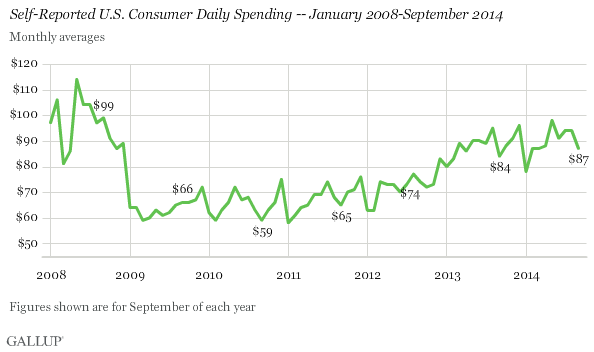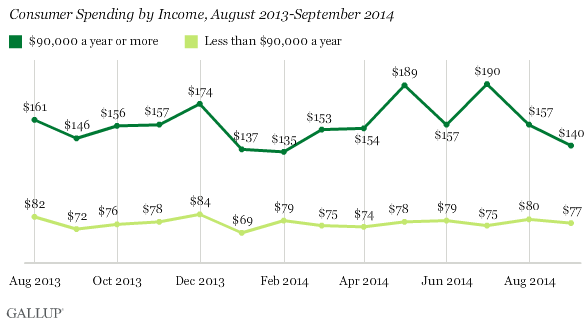U.S. Consumer Spending Drops Slightly in September
WASHINGTON—Americans’ daily self-reports of spending dropped to an average of $87 in September, down from $94 in July and August. However, spending in September this year was slightly higher than the $84 average for September last year.

These findings are based on Gallup Daily tracking interviews with more than 14,000 Americans throughout September. The poll asks Americans to report the total amount they spent “yesterday” in stores, gas stations, restaurants, or online—not counting home and vehicle purchases, or normal monthly bills—and gives an indication of their discretionary spending.
The drop in spending Gallup found in September is not unusual. Since 2010, spending has dropped each year between August and September, although the size of the drop has varied. The consistent declines may be the result of increased spending in August, thanks to back-to-school purchases and summer vacations.
September’s $7 drop in average spending is comparable with past August-to-September drops. Last year, the drop was $11, from $95 in August to $84 in September.
Monthly averages in self-reported spending so far in 2014 have generally exceeded average spending for the corresponding month in 2013, and especially so for 2009 to 2012, when averages were generally in the $60 to $70 range. However, this year's monthly averages are still lower than the nearly $100 averages seen in 2008.
In September, daily self-reports of spending among upper-income Americans (those with annual household incomes of $90,000 a year or more) fell for the second month in a row, to average $140 a day -- well below the 12-month high of $190 in July, and near February's 12-month low of $135.

Spending among middle- and lower-income Americans—which tends to be much more stable—dropped only slightly, from $80 in August to an average of $77 in September. Reported spending among this group in the past 12 months has fallen into the narrow range of $84 (in December 2013) to $69 (in January 2014).
Get the TV Tech Newsletter
The professional video industry's #1 source for news, trends and product and tech information. Sign up below.
While Americans’ average self-reported daily spending dropped in September, decreases from August to September are common, and average September spending this year exceeded September spending last year. With consumer spending a major driver of the U.S. economy, changes in average spending can reflect how the economy is doing.
Spending has generally increased since 2010, during the aftermath of the recession. And, compared with September 2013, spending increased this September. However, the consecutive two-month drop in spending among upper-income Americans could be a troubling sign, as this group generally has higher discretionary spending than middle- and lower-income Americans.
